Running Hot and Cold
Iceland Stream Study Provides a Preview of Climate Change
(Updated August 2021)
To its natives, Iceland is a mystical island, peopled with huldufólk—hidden folk, or elves—and the countryside is peppered with little stone “fairy houses” built by locals to house their supernatural neighbors.
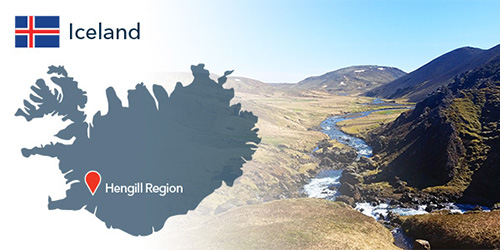
“Within that landscape, it’s just so easy to do ecology.” Photos Courtesy: Jim Hood, Lyndsie Collis and Jon Benstead
Some ecologists may be inclined to believe in at least a certain kind of Icelandic magic, the kind that resulted in the remarkable Hengill region, a landscape coursing with crystalline streams that flow at dramatically different temperatures. Just a few steps from each other, one brook may babble at 7°C (44.6°F) while another, warmed by a small patch of geothermally heated earth, can run as high as 30°C (86°F). What’s just as unique, the heat sources have very little impact on stream chemistry.
"Within that landscape, it's just so easy to do ecology. It's a really fun ecosystem to work in," marvels Jim Hood, an assistant professor of aquatic ecology at The Ohio State University, who did his postdoctoral research at Hengill. This remarkable project observed the impact of warming on stream ecology, which is helping scientists predict the impacts of global change on streams and rivers."
It’s not just great to be an ecologist at Hengill; it’s also a great place to be an alga.
“Summertime in Iceland is a fantastic place to be if you’re in a warm stream and there’s a lot of light and plenty of phosphorus coming out, naturally, from the relatively new rock,” says Jon Benstead of the University of Alabama, one of the principal investigators on the warming study.
Over the course of seven years, Benstead and Hood worked with a diverse crew of ecologists and biologists, including Wyatt Cross of Montana State University, Alex Huryn of the University of Alabama, Jill Welter of St. Catherine University in St. Paul, Minnesota, Gísli Már Gíslason of the University of Iceland, and Jón Ólafsson of Iceland’s Institute of Freshwater Fisheries, and troops of undergraduate and graduate students from across the U.S.
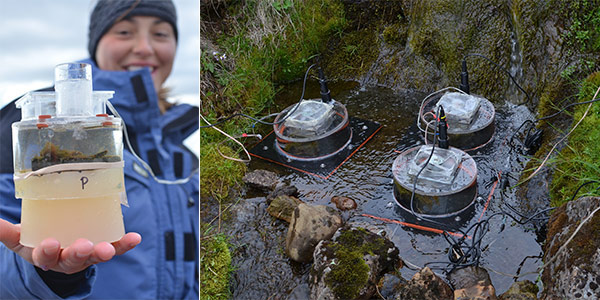
Respiration chambers with YSI ProODOs provided lab-like capabilities in remote streams.
Past and Future
Because of its unique geology and hydrology, Hengill provides a remarkable view of the past in the newly hewn volcanic landscape with fresh, shallow soils. It also offers a peek at the future, as Benstead, Hood and their colleagues warmed streams and enriched them with nutrients to study the effects that global climate change could have on rivers around the world.
>> Download full copy of Mission: Water Magazine
“It’s the interaction between temperature and nutrients that really drives the research,” says Benstead. He helped lead the design of an ingenious set of studies, funded largely by the National Science Foundation, to examine the impact of temperature increases and different nutrient levels on ecosystem metabolism (the growth of algae and its respiration, as well as the decomposition of organic matter) and invertebrate communities in streams.
In 2010, Cross, Benstead, Huryn and Hood kicked off their research by starting to gather monthly data on two streams in Hengill, setting the baseline for respiration and life in each. They then raised the temperature of the cooler stream by about 4°C using a three-stage, gravity-fed heat exchanger system submerged in geothermally warmed water. This allowed them to study the effects on stream metabolism, nutrient cycling, flora and fauna.
Zooming in from the whole-stream warming level, the team then created narrow, three-meter-long channels lined with tiles on which biofilm could grow. Fifteen channels provided three replicates of five different temperature regimes.
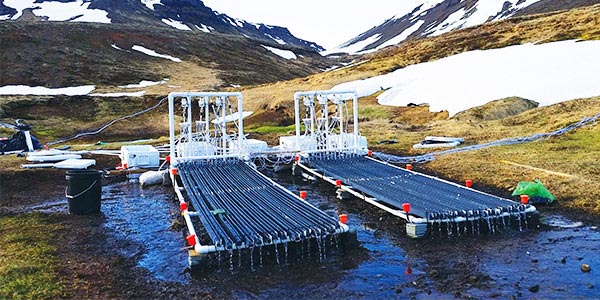
Tile-lined channels provided insight on stream responses to temperature changes.
“We had to tease out the effects of temperature first,” Benstead explains.
"Now we can see that at higher temperatures we get increasing nitrogen limitation and nitrogen-fixing activity."
Later, the array expanded to 30 channels and included nitrogen fertilizer dripped into the water to overlay different rates of nutrient enrichment on top of temperature changes. Tiles were removed from the channels and placed into chambers where researchers measured rates of respiration, photosynthesis, nitrogen fixation and nutrient uptake. Then the biofilm was scraped from each tile and the living community was analyzed.
Remarkable Logistics
There is nothing simple about conducting science at Hengill—not even getting to the research site. At 40 kilometers (25 miles) from Iceland’s capital city, Reykjavik, it’s a relatively quick ride in the summer, but a trial in winter weather.
For Benstead, whose previous work in northern Alaska made him no stranger to the Arctic, a seven-month sabbatical in Iceland was a shock. “It was more difficult to work [at Hengill] than on the North Slope of Alaska,” he says. “We had a helicopter in Alaska, so it was a lot easier to get around. But there’s also a difference in winter weather. Most of the time, Alaska in winter is high-pressure—cold, but clear. It’s completely different in Iceland, which is in the middle of the North Atlantic. It can be 10° on either side of freezing on any one day. You can have freezing fog one day, a blizzard the next, and
then rain.”
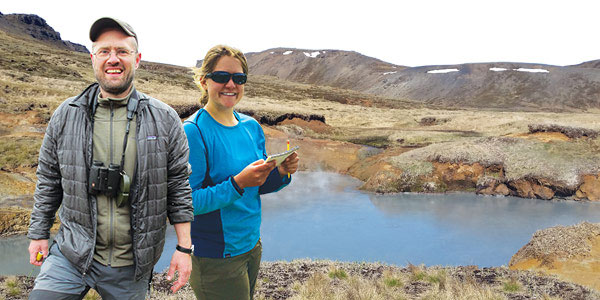
Principal investigator Jon Benstead and Lyndsie Collis at a geothermal pool.
Hood lived in Iceland for nearly two years, conducting monthly data collection in those ever-changing winter conditions.
That made the commute to work an adventure, he says. For starters, the four-mile dirt track that the scientists could drive in the summer became a four-mile hike when the road closed for winter.
“We used every single approach you could think of,” Hood recalls. “We hiked in a lot. We skied in a lot. We snowmobiled in a lot.”
The team even contracted with a local rescue squad whose Land Cruiser was outfitted with super-wide, low-pressure flotation tires to drive across the surface of the snow as if it was on snowshoes. Even that specially outfitted rig ended up buried in drifting snow.
So did the team’s instruments, including nearly two dozen YSI ProODO handheld optical dissolved oxygen meters (now the ProSolo ODO), some of which spent significant time in frigid temperatures.
Summer Adventures
In the Icelandic summer, the geothermally warmed streams of Hengill are crawling with snails and other invertebrates…and packs of scientists trying to make the most of the handful of long, Arctic days.
“Summers are really short,” laughs Jim Hood, who was a Montana State University post-doctoral researcher on an ingenious stream warming project from its start in 2010 through its wrap-up in 2016, and a full-time Iceland resident for the first two years of the project. “It’s expensive to get to Iceland and we don’t have a lot of time. Summer lasts about 90 days. Everybody’s tired, but really excited, by the end of the summer.”
With two to five undergraduate students, three PhD students and two master’s degree candidates hitting the field to participate in the research, simplicity and reliability were vital to getting the team up and running each summer. Principal investigator Jon Benstead of the University of Alabama notes that his collection of YSI ProODO meters were chosen for their versatility and plug-and-play interface.
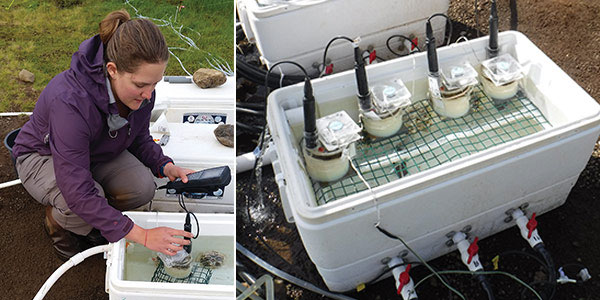
The research teams array of YSI ProODO water quality sampling handheld meters.
“They’re very rugged, simple to use,” Benstead notes. “It doesn’t take long for students to learn how to set them up—setting up the logger is pretty intuitive. It’s pretty simple to synchronize them all, the clocks are good in them, and there’s plenty of memory.”
Still logging data since 2010, most of the team's ProODO meters have survived hard duty, from wintertime use to a few incidents with a truck.
“The loggers are pretty bomber,” says Hood enthusiastically. “They’ve gotten really wet, taken a lot of abuse and they’re still working.
“Seven years later, we’ve still got 14 left—and most of the ones that broke are because I ran over them,” he confessed.
Versatility in the Field
“We were looking for something we could use in the field at very low temperatures,” Benstead explains. Just a fraction of the price of more sophisticated sondes—a huge consideration when stocking up on 20 instruments–the ProODO meters combined handheld versatility with onboard datalogging and a large memory.
The team also built respiration chambers to create laboratory-like conditions in the field. With ports sized to fit the ProODO probes, stirrers rigged from battery-operated computer fans, and large stoppers that allow quick drainage, the chambers permitted metabolism studies on the spot.
“We were taking the tiles out of the stream and putting them into the chamber,” Benstead explains. “You never want to take things back to the lab.”
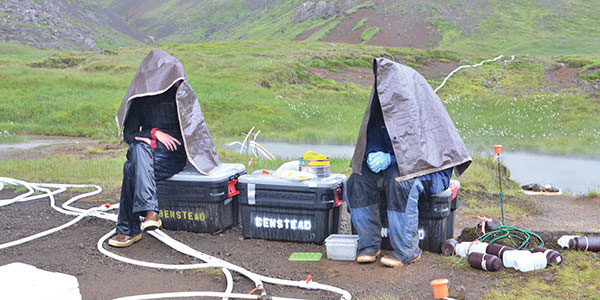
Despite its natural beauty, staying dry in the Hengill Region is its own challenge.
Surprising Results
Results from the Hengill study, now being published in a series of papers and journals including Global Change Biology and Ecology, yielded some surprises.
“The theory was that primary production is going to increase a little bit, but the results saw much larger increases than we expected,” says Hood.
In fact, temperature increases led to explosions of primary productivity. For instance, warming a stream by an average of 3.3°C (5.9°F) over a year tripled the net primary production and nearly tripled the rates of nitrogen and phosphorus use efficiency.
In the whole-stream warming experiment, warming led to flushes of Ulva, a filamentous alga that dramatically shifted nutrient cycling and nitrogen efficiency patterns.
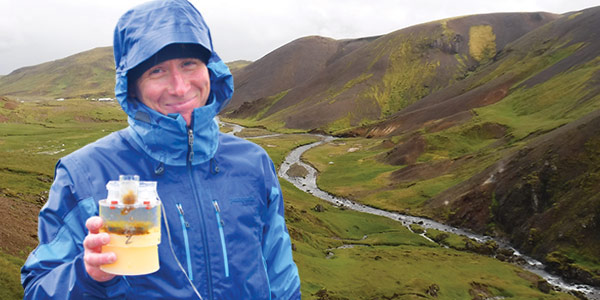
Jim Hood displaying the explosive growth of Algae related to their study.
“Algae growing after warming tended to need less nitrogen,” explains Hood. “They were more efficiently using it. We also think there was more efficient cycling in algal mats—little bugs eat and release nitrogen more quickly at warmer temperatures, and some diatoms in those mats have endosymbionts that fix nitrogen in the summer.”
In another element of the study, a boost in mean water temperature of 3.8°C (6.8°F) over two years resulted in a population shift from cold-adapted midges to snails that slowly colonized the warming stream—a direct contrast to the team’s expectation that average body size would become smaller in response to higher temperatures.
In short, the Hengill experiments demonstrated that the theories derived from single-species lab studies may be challenged in real-world conditions. That has huge implications for scientists trying to predict the impact of, say, warmer water carrying nitrogen runoff into Lake Erie, or policy makers trying to decide whether wastewater treatment plants should continue focusing only on phosphorus reduction, or if nitrogen should be controlled, too.
“It’s allowed us to tackle some of these theoretical ideas in the real world,” says Hood. “It’s allowed us to see where the theory works and where it doesn’t. Because the landscape lends itself to these comparisons, we can create nice, manipulative experiments.”
Packed In
Jon Benstead of the University of Alabama is an experienced hand at working far from the lab, whether it’s on the North Slope of Alaska or in the rolling hills of Iceland—the sorts of places where you can’t run a longer extension cord to find an outlet, or jog down to the corner store for supplies.
That’s made him an expert on packing luggage, which he points out can save thousands of precious grant dollars per trip that would otherwise be sunk into freight costs. To supply his stream warming study in Hengill, Iceland, Benstead and his team disassembled a heat exchanger and 365 meters (1,200 feet) of flexible PVC tubing and packed the pieces as luggage, along with mounds of other scientific equipment. In all, he and four colleagues checked 950 pounds of gear to Iceland in 14 bags for a cost of $950.
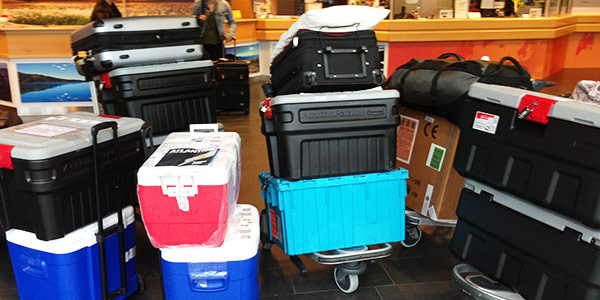
“Have a good luggage scale in your lab, and know absolutely everything you have to know about your airline’s baggage policy,” Benstead advises fellow water experts headed for the field. “And any time you’re packing, make sure you have checklists and good inventories for everything. It’s all about planning, isn’t it?”
>> Download full copy of Mission: Water Magazine
If you'd like to have your research or study published in one of our next issues of Mission: Water magazine, please send us an email and we'll discuss the possibility! Send email to missionwater@xyleminc.com and Brandon or Patrick will reach out to you!